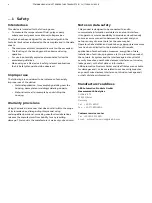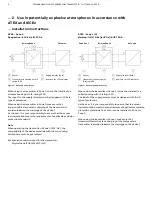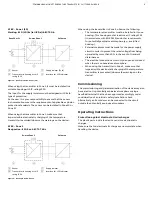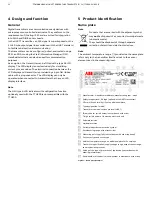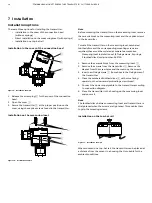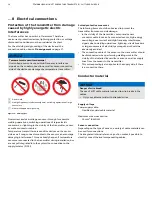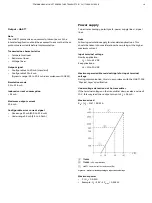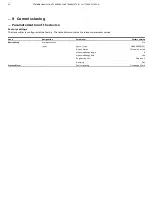
TTH200
HEAD-MOUNT TEMPERATURE TRANSMITTER | OI/TTH200-EN REV. B
9
ATEX - Zone 1 (20)
Marking: II 2 G (1D) Ex [ia IIIC Da] ib IIC T6 Gb
Zone 20 or 21
Ex-area Zone 1
Safe area
A
Sensor
B
Transmitter in housing with IP
rating IP 20
C
Supply isolator [Ex ib]
D
Interface for LCD indicator
Figure 4: Hookup in ATEX - Zone 1 (20)
When using the transmitter in Zone 1, it must be installed in a
suitable housing with IP -rating IP 20.
The input for the supply isolator must be designed with ‘Ex ib’
type of protection.
As the user, it is your responsibility to ensure that the sensor
instrumentation meets the requirements of applicable explosion
protection standards. The sensor can be installed in Zone 20 or
Zone 21.
When using the transmitter in Zone 1, make sure that
impermissible electrostatic charging of the temperature
transmitter is avoided (observe the warnings on the device).
ATEX - Zone 2
Designation: II 3 G Ex nA IIC T1-T6 Gc
Ex-area Zone 2
Safe area
A
Sensor
B
Transmitter in housing with IP
rating IP 54
C
Supply isolator
D
Interface for LCD indicator
Figure 5: Hookup in ATEX - Zone 2
When using the transmitter in Zone 2, observe the following:
• The temperature transmitter must be installed in its own
housing. This housing must at least meet IP rating IP 54
(in accordance with EN 60529) and other requirements
for potentially explosive atmosphere (e.g. a certified
housing).
• External measures must be made for the power supply
circuit in order to prevent the rated voltage from being
up-scaled by more than 40 % in the event of transient
disturbances.
• The electrical connections must only be opened or closed
when there is no hazardous atmosphere.
• When using the transmitter in Zone 2, make sure that
impermissible electrostatic charging of the temperature
transmitter is prevented (observe the warnings on the
device).
Commissioning
The commissioning and parameterization of the device may also
be carried out in potentially explosive atmospheres using a
handheld terminal that has been approved accordingly under
consideration of an intrinsic safety installation check.
Alternatively, an Ex modem can be connected to the circuit
outside the potentially explosive atmosphere.
Operating instructions
Protection against electrostatic discharges
The plastic parts inside the device can store electrostatic
charges.
Make sure that no electrostatic charges can accumulate when
handling the device.
Change from two to one column




